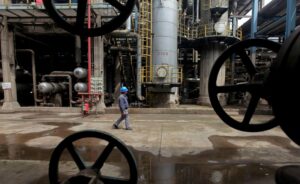Rolls-Royce employees to benefit from stunning turnaround as it hands out nearly £30 million of company shares
Rolls-Royce employs approximately 42,000 people, all of whom will receive a piece of the company as its business booms.


Under Tufan Erginbilgiç, who took over as CEO of the British engine company in January 2023, the company’s profits have soared thanks to his prudent financial approach and a post-pandemic travel boom.
Rolls-Royce’s employees will receive the fruits of their labor, too.
The company is rewarding its employees with 150 shares per employee, worth over £700, to recognize their part in helping the engine maker emerge from the pandemic’s lows.
Rolls-Royce said the shares would be for “every colleague, in every part of our organisation” in a memo reported by the Financial Times last week and seen by Fortune.
“We want to recognise your contribution to our future success and reward you for the role you will play in it,” Erginbilgiç said in the memo.
Although Rolls-Royce has an internal share-purchase program for employees, this will be its first time rewarding them with stocks. It has looked out for its employees in different ways in the past—for instance, in 2022, under former CEO Warren East, the company offered lump-sum payments and pay rises to employees as high inflation and interest rates caused living costs to surge.
“Our strong first half results and the progress we are making on our transformation have been made possible thanks to the hard work and action of our people,” a Rolls-Royce spokesperson told Fortune.
The FTSE 100 company’s shares are up 112% in the last year.
Rolls-Royce employs approximately 42,000 people, so the program will cost it an estimated £30 million. The company said that in the U.K., employees won’t be able to sell their shares for three years and if employees wait five years or more before selling them, they won’t be taxed.
Riding the wave
Business is booming for the London-listed company, which announced plans to pay dividends again for the first time since the pandemic. Rolls-Royce had a bumpy ride amid lockdowns and travel restrictions as the British company earns much of its money from the upkeep of engines when they are in use.
But when Erginbilgiç took over last year, he moved fast to make sweeping changes.
The former BP executive recognized that Rolls-Royce’s situation was tantamount to a “burning platform” as it was underperforming compared to its rivals. So, he streamlined the company’s operations, slashed jobs to cut costs, and renegotiated engine contracts that focused on the ones with higher returns.
The results followed within months as Rolls-Royce reported a fivefold profit increase in the first six months of 2023. During the full year, the company’s profits doubled.
It helped that travel demand began picking up and supply chain snarls started easing around the same time, too, giving the company a much-needed boost. Rolls-Royce has also recently inked lucrative deals, including one worth up to $20 billion with Turkish Airlines and Airbus to produce aircraft parts.
Last week, Rolls-Royce published strong first-half results and raised its 2024 profit and cash flow forecasts to up to £2.3 billion and £2.2 billion, respectively, in a sign of the company’s changing fortunes. This puts it well ahead of its financial goals for 2027.
The engine maker’s civil aerospace division benefited from the increase in flying hours outstripping those of the pandemic, as did its defense and power system units. Rolls-Royce saw its operating margin increase to 14% from 9.7% a year earlier.
Supply chain snags continue to loom over the company—an issue it shares with other aviation majors such as Airbus. But Rolls-Royce is, er, on a roll, nonetheless.
“Our transformation of Rolls-Royce into a high-performing, competitive, resilient, and growing business is proceeding with pace and intensity,” Erginbilgiç said in a statement announcing the company’s earnings last week.







